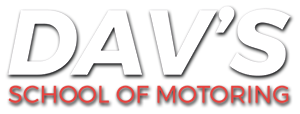Driving Courses


Taxi Tuition
Dav's School of Motoring is proud to offer tuition and preparation for prospective Taxi drivers. This training is formulated by the DIA and designed to give you all the information that you need to take and pass either the DSA or DIA Taxi test.
Hackney Carriage & Private Hire
As an experienced driver you should already have the skills required to pass. However, with only 9 driver faults ("Minor faults") allowed you cannot afford to let these affect your chances of success. with this in mind, our approach is to advise rather than instruct and to point out the possibilities which may not have occurred to you.
We will ensure you are prepared for the day of the test, which can be taken in our car if you wish (If so, please contact us prior to booking to check availability). Test day charges vary, so please check prior to booking.
Working as a professional (taxi) driver requires an extra dimension with regard to safety and as such, we offer efficient, concise training to identify your individual needs. In addition to your training we offer on-going advice and guidance should you require it. This verbal and written support is part of our continuous support package and comes at no extra charge.
The Taxi Assessment Test
The standard needed to pass the test will be higher than that of a learner driver taking the standard practical driving test and will take into account issues specifically related to taxi driving. The main focus of the test will be on road safety and the safe conveyance of passengers. Your passengers must feel safe at all times.
The driving part of the test will last for around forty minutes. You will have to drive on a wide range of roads and in a variety of road traffic conditions.
Turning The Car Around
The test will require you to carry out a 'turning the car around in the road' manoeuvring exercise. The examiner will select a section of road where their are various options available to do this. You will have to select the safest and most appropriate method of turning the car around. Methods you can choose from are:
Turn in the road
Left or right reverse
U-turn within the width of the road
Using the mouth of a junction on the left or right in which to swing around
Reversing into a side road on your left or right
When performing any of the above you must make sure you do not mount or hit the kerb or use a private driveway. All manoeuvres must be made safely, under control and in accordance with the Highway Code.
Stopping At The Side Of The Road
As this is common practice when driving a taxi the examiner will require you to perform two or three stops. You should:
Pull up at a reasonable distance from the kerb where it is safe, legal and convenient
Apply the handbrake
Select neutral gear
Make sure there are no obstructions, such as a street light, that would stop a passenger opening the door
Independent Driving
New to all practical driving tests from 2010. The examiner will ask you to drive by following road sign and/or verbal directions.
The Wheelchair Exercise
This is optional but must be taken if the vehicle you intend to use as a taxi is fitted with special equipment to allow easy access for wheelchairs and people with special needs.
You will need to load and unload a wheelchair safely, and make sure it is secured for any journey. The examiner will ask you to:
Load and unload a wheelchair safely
Securely and correctly erect the wheelchair ramps
Safely and correctly install the wheelchair in your vehicle, backing the chair to the fold down seats
Secure both the wheelchair and brakes
Secure seat belt/safety harness and also secure wheel belts/clamps if they are fitted to your vehicle
Highway Code Cabology Questions
At the end of the test you will be asked ten questions:
Three will be on the Highway Code
Two on Cabology - on the safety of your vehicle, your responsibilities as a taxi driver, on the safety of your passengers
Five on traffic signs
How The Test Is Marked
The examiner will mark you as they would a learner driver taking the normal practical driving test. For more information, please see how the driving test examiner expects you to drive.
If you commit ten or more driving faults you will fail; a learner can score fifteen. You will also fail if you score one dangerous or serious fault:
Driving Fault - a non-dangerous fault such as hesitating at a junction or signalling too late
Serious Fault - recorded when a potentially dangerous incident has occurred or a regular driving fault shows a serious weakness in the candidate's driving
Dangerous Fault - an incident that caused actual danger while driving
Booking The Taxi Assessment Test
You can book the test as you would a normal driving test - either online at Direct.Gov or telephone 0300 200 1122.
